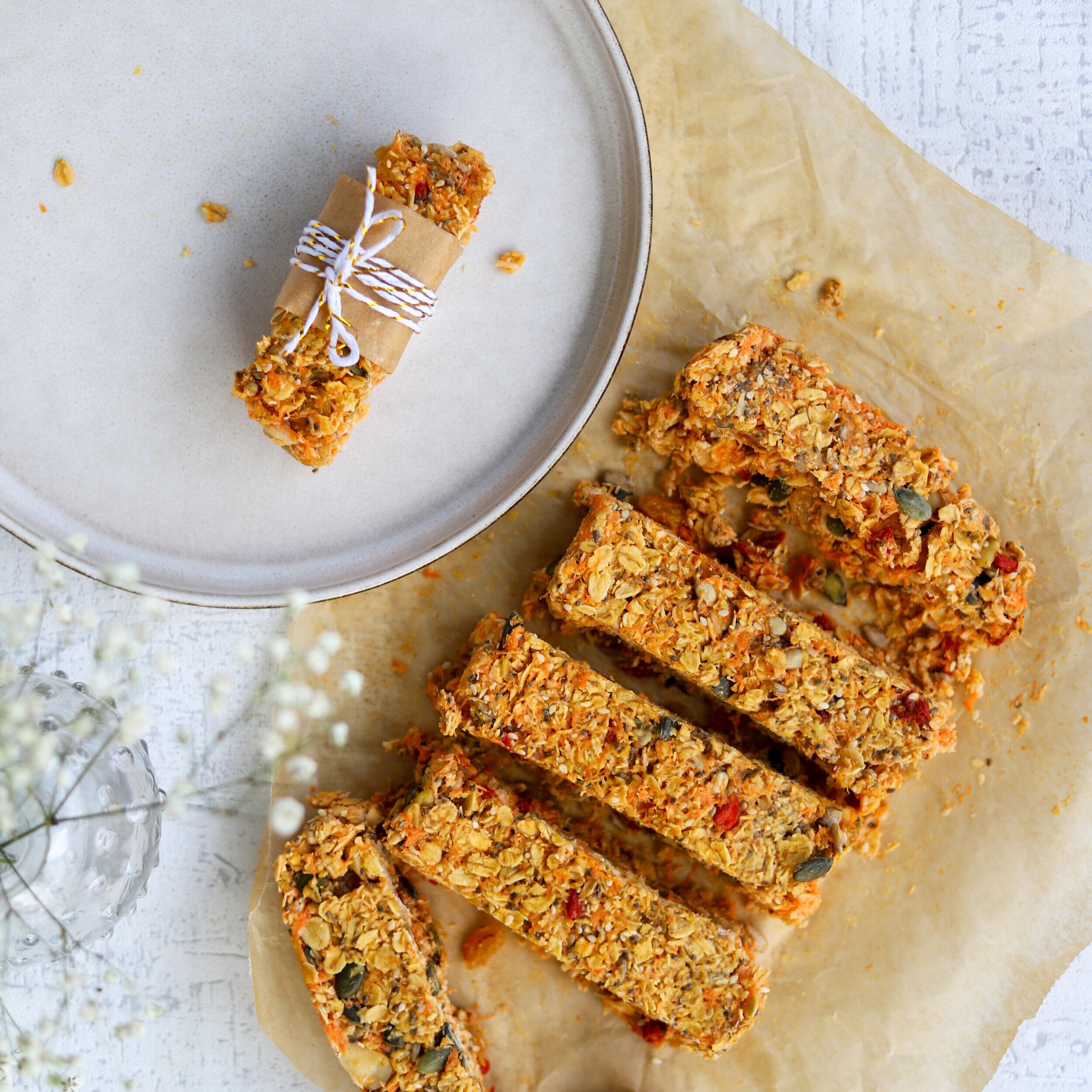Ingredients for 5 flapjacks:
1-2 tablespoons of maple syrup, agave or honey
2 tablespoons of coconut oil
1 carrot, grated
80g of oats
1 tablespoon each of pumpkin, sunflower, chia and sesame seeds (if you don’t have one, use double of another)
3 tablespoons of desiccated coconut
A handful of Brazil nuts, roughly chopped (optional)
2 tablespoons each of goji berries & raisins
1 scoop of whey protein (optional)
3 tablespoons of any milk
1/2 teaspoon each of cinnamon & vanilla essence
Method:
Line a lunch box/ Tupperware with greaseproof paper.
Melt the coconut oil in a small pan.
Add all of the ingredients to a bowl.
Pour in the coconut oil. Stir really well. I mean really well.
Taste to see if you like the flavour & adjust if necessary (i.e. add more honey if it isn’t sweet enough or perhaps a bit more cinnamon).
Press the mixture into the Tupperware and smooth out the top.
Freeze for 30 minutes to firm it up.
Cut into bars and store in the fridge.
Cucumber, sesame and smoked tofu salad
Crunchy cucumber with ginger, creamy avocado, hints of chilli/ coriander, edamame, smoked tofu and a lime, soy and sesame oil dressing.
It’s a tasty one.
Give it a go.
Shopping notes:
Edamame is available frozen and may be sold as soya beans. If you can’t find it, frozen broad beans or tinned chickpeas will do the trick too.
Ingredients to feed 2:
1 cucumber, cut into half moons
thumb size piece of ginger (25g), grated
a large handful of coriander leaves
2 spring onions, sliced
150g edamame beans
8 radishes, finely sliced
2 avocados, peeled and sliced
1 red chilli, finely sliced
1-2 teaspoons of sesame seeds
300g smoked tofu, cubed
sea salt and black pepper to season
rapeseed oil for cooking
For the dressing:
Juice of 1 lime
2 teaspoon of tamari or good quality soy sauce
2 teaspoons of agave or maple syrup
6 teaspoons of sesame oil
Method:
Put the cucumbers into a bowl, season with sea salt and black pepper and squeeze over the juice of the grated ginger. If some of the grated ginger falls in then this isn’t a big deal.
Set this aside whilst you make the rest of the salad.
Put a frying pan on a medium-high heat with a splash of rapeseed oil in it.
Throw in the cubed tofu and cook until crispy on most sides.
Put the frozen edamame beans in a small saucepan and add enough water to cover. Bring to the boil then take it off the heat and drain. Either run it under some cold water or allow it to cool naturally.
In a large bowl, combine the edamame, spring onion, avocado, radish, chilli and coriander leaves. Season with a small amount of black pepper and stir to combine.
Add the cucumber and stir again.
Whisk together the dressing ingredients and tip this over the salad.
Stir to combine then divide between two plates/ bowls.
Top with the smoked tofu cubes and sprinkle the sesame seeds over it all.
Whole baked cauliflower, roasted red pepper sauce, chimichurri, hazelnut dukkah
Our food isn’t merely a bunch of macronutrients, vitamins and minerals, it is way more complex than this.
Bioactive compounds present in plants form a small proportion of the food we eat.
These are not vitamins or minerals but they are very good for us. If you see a health claim on a particular food, it is almost always likely to be because of the bioactive compound.
Curcumin in turmeric is an example.
Bioactive compounds are especially high in herbs and spices and in different coloured vegetables.
This recipe capitalises on some of the best bioactive compound-containing ingredients to create an incredibly tasty (& fancy looking) dish.
In case you are not a fan, cauliflower is easily replaced with a baked sweet potato or a chunk of any roasted veg.
Ingredients for 2:
1 small cauliflower (1 large cauliflower will serve 4)
rapeseed oil
sea salt & black pepper
150g dry weight quinoa (or 1 ready-cooked quinoa pouch)
For the roasted red pepper sauce
1/4 of a tin of chopped tomatoes
2 peppers
1/2 jar of sun-dried tomatoes (75g drained weight)
For the chimichurri
1 bunch of parsley
1/2 bunch of oregano
1-2 shallots (dependant on size)
1 clove of garlic
1 red chilli, optional
1 lemon
Italian olive oil
For the hazelnut dukkah
1 tablespoon of fennel seeds
1 tablespoon of cumin seeds
1 tablespoon of coriander seeds
2 tablespoons of sesame seeds
50g hazelnut (ideally blanched hazelnuts)
Method:
Preheat the oven to 180 degrees C.
Put the cauliflower in an ovenproof dish with a lid and drizzle with oil or wrap it in tin foil.
Bake for 1 hour, until the cauliflower is soft and fully cooked through.
Cook the quinoa according to packet instructions and season well with sea salt and black pepper.
To make the dukkah, put all of the ingredients on a small ovenproof roasting tray and roast for 10 minutes. The spices should become fragrant and the hazelnut golden in colour.
Allow it to cool completely then pulse in a blender to roughly break the ingredients up.
To make chimichurri, finely chop all of the ingredients aside from the lemon and transfer them to a bowl.
Add the juice of 1/2 lemon, a pinch of sea salt and stir in enough olive oil to give it the consistency of pesto.
Taste and add more lemon if needed.
To make the roasted red pepper sauce, cut the sides of the pepper off and lay them on a roasting tray, skin side up. You should have 4 flat pieces per pepper.
Put the pepper slices under a hot grill and grill them until the skin blackens and blisters.
Take them out and allow them to cool.
Once they are cool enough to handle, peel off the blackened skin and transfer the pepper pieces to a blender.
Add 1/2 jar of drained sundried tomatoes and a 1/4 of a tin (100ml) of chopped tomato.
Blend until completely smooth.
To serve, put 2 tablespoons of the roasted red pepper sauce on a plate and swirl to form a circle.
Add 3-4 tablespoons of quinoa, a 1/4 or 1/2 of the roasted cauliflower.
Top with a couple of tablespoons of chimichurri and a tablespoon of the hazelnut dukkah.
Celery ice cubes
Ingredients to make 1-2x weeks’ worth of celery ice cubes:
1 head of organic celery
1 organic cucumber
juice of 1/2 a lemon (optional)
thumb size piece of ginger (optional)
Method:
Wash everything.
Roughly chop the celery & cucumber and pop it in a blender.
Add a splash of water and blend until completely smooth.
Depending on your blender you may need to add more water.
If you find the taste challenging then add the lemon & ginger.
Sweet potato, chickpea & spinach curry
Curries, especially curry pastes are a great opportunity to top up on nutrients.
Rather than go for a shop-bought version, try blending a few ingredients together to form that flavour paste.
It is the easiest thing to do and you’ll get way more nutrients out of it.
Plus blending everything together is a good opportunity to hide vegetables if you aren’t keen on them.
This mild and fragrant curry combines turmeric, ginger, garlic and green pepper in the paste with sweet coconut milk, sweet potato and chickpeas.
It works well with chicken instead of chickpeas too. In fact, beyond the curry paste and coconut milk, you can virtually include any ingredient.
Ingredients to feed 2
1 large sweet potato, peeled & cubed
1 tin of chickpeas
1 tin of full fat coconut milk
100g of spinach
1 green pepper, roughly chopped
Thumb size piece of ginger, peeled & roughly chopped
2x turmeric root, roughly chopped
1 onion, roughly chopped
2 cloves of garlic, sliced
1 chilli (optional)
Fresh coriander & black rice to serve
Sea salt & black pepper to season
Oil for cooking
Method:
Pop a frying pan on a medium heat. Add a splash of oil & the cubed sweet potato.
Whilst the sweet potato is cooking, make the curry paste by blending the pepper, onion, ginger, turmeric, garlic & chilli with a splash of water until smooth.
Pour the curry paste over the sweet potato and cook for a couple of minutes until thickened.
Season well then add the coconut milk.
Let it bubble on a medium heat until the sweet potato is cooked.
Stir in the chickpeas and spinach.
Season again and cook just enough for the spinach to wilt.
Serve with black rice & fresh coriander.





